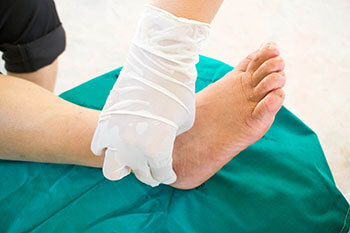Our podiatrists provide wound care in the areas of Flushing, NY 11356, Elmhurst, NY 11373 and Brooklyn, NY 11214. Call our offices today: Flushing, Elmhurst or Brooklyn at (646) 520-7027 if you are dealing with non-healing wounds & ulcers.
Foot Wounds & Ulcers Treatment in Flushing, Elmhurst & Brooklyn, NY

For those with diabetes, early prevention and prompt treatment for wounds can be crucial to maintaining healthy feet. Unfortunately for those with diabetes, minor wounds have the ability to turn into serious ulcers if left uncared for. Simply walking in new or tight-fitting shoes can be enough to form a serious foot condition. Diabetes affects the nerves of the feet, sometimes leaving them with little or no feeling. If a wound therefore develops and isn’t felt, it may be hard for that person to recognize they need care.
How Does a Diabetic Foot Wound Develop?
Diabetic neuropathy is the medical term given to nerve damage caused by diabetes. Diabetes causes heightened blood glucose levels which, in turn, can lead to nerve damage. Diabetic neuropathy can develop over time and symptoms typically show up in the feet first. There may be numbness or pain, pins-and-needles or burning sensations, sensitivity to touch, muscle weakness and more.
Numbness in the feet can make it difficult or even impossible for the diabetic to detect an injury to the skin on the feet such as a cut, scrape, burn, callus, hot spot, etc. Not being aware of these injuries prevents a person from treating it. Making matters worse, poor circulation caused by diabetes reduces blood flow in the feet. Blood carries oxygen and nutrients, both of which are essential to healing.
Without an adequate flow of blood to the injury site, the body cannot heal itself properly, and even the smallest disturbance in the skin has the potential of developing into a wound. If a wound does develop, it is critical to be under the care of a podiatrist. They will use a variety of treatments to treat the wound, and instruct the diabetic on how to keep it clean, and covered with a special kind of dressing. They will advise keeping pressure off of the wound and may prescribe special footwear, braces, etc. to aid in this effort.
When Diabetic Wounds Don’t Heal
Wounds in a person with diabetes can be dangerous. A diabetic wound can heal slowly, not heal properly, or in some cases, never heal, making it an ulcer. Ulcers that are not healed promptly and properly have the potential of becoming infected and, sometimes, this infection may even spread to nearby tissue and bone, which is a serious health issue. An infection, and/or lack of blood flow can cause tissue to die, which is known as gangrene. Dead tissue must be surgically removed to prevent bacteria from entering and spreading through the bloodstream. This procedure is known as debridement. Early detection and intervention are extremely important in mitigating the risk to healthy tissue, and to prevent an amputation from becoming necessary.
Diabetic Wounds & Ulcers Prevention
To avoid ignoring wounds and to help prevent the development of serious foot conditions, it’s advised to check your feet daily for any abnormalities. Things to look for include cuts, blisters, bruises, calluses, corns, sores, cracked skin, redness, bumps, lumps, ingrown toenails, puffy skin, tenderness, pain, or differences in temperature. Anything out of the ordinary should be reported to a podiatrist immediately. It can also be beneficial to wear comfortable shoes with extra support. Avoiding high heels and other tight-fitting shoes may help in preventing certain foot complications. You should also be careful in how you trim your toenails. Avoid cutting at an angle and digging into the sides of skin surrounding the nail. Lastly, be sure to wash and dry your feet thoroughly to maintain proper hygiene for your feet.
Visit your Foot Doctor
Because wounds are a potentially dangerous condition for any diabetic, regular check-ups with a podiatrist should be part of the diabetic patient’s foot care regime. For information on wound care and wound prevention, we recommend you speak with a podiatrist for professional care and advice.
